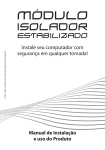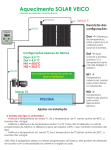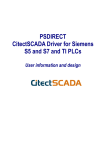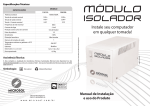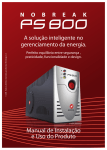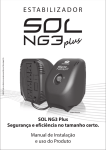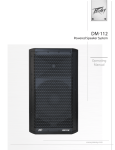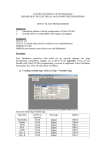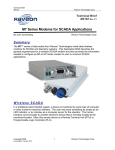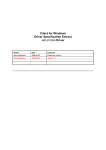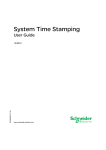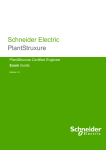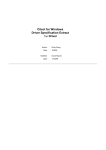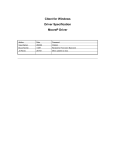Download User Manual - Schneider Electric SCADA & MES Global Support
Transcript
Advanced Technology Systems User Manual Document Title IEC870-5-101 Driver for Citect User Manual Revision Revision 107 Revision Date By April 16, 2002 Paul Whitfield File Name IEC870t_Driver_Manual.doc Copyright: This document contains proprietary information of Microsol Limited. None of the information contained in this document may be reproduced or disclosed to others without written authorisation by Microsol Limited. The information in this document is subject to change without prior notice and should not be construed as a commitment by Microsol. Microsol do not assume responsibility for any errors that may be in this document. Microsol IEC870-5-101 Driver for Citect User Manual Revision 107 Revision History Date Rev 000 001 002 003 004 Author SK SK SK SK PSW 105 PSW 106 PSW 107 PSW Comments Created and initial releases Changed company name to Microsol and correct various problems Changed numbering to be V105 (rather than 005) Reorganised structure of document Added alarm server description Added description of SOE processing Removed SOEQUE and PROCESSCOS as they are not supported. Incorporated review comments Added support for short floating point measurands Added DefaultAnalogSOEMode parameter Added TimeoutCount parameter Added StoreDigitalInQual parameter Added description of communication statistics Changed default Intercharacter timeout to 100 ms Added ability to log raw i/o to kernel log Added reference to Citect 5.4 Service Pack Cs Approval Date Rev Reviewer IEC870t_Driver_Manual.doc Release Notes Last Revised: 16 April, 2002 Page 2 of 38 Microsol IEC870-5-101 Driver for Citect User Manual Revision 107 Table of Contents 1. Introduction ....................................................................................................................................5 1.1 Driver Operation........................................................................................................................5 2. Getting Started ...............................................................................................................................6 2.1 Driver Installation.......................................................................................................................6 2.2 Determining Driver Copy Protection License Key .....................................................................6 2.3 Adding a New Protocol Entry ....................................................................................................7 2.4 Citect I/O Forms Configuration .................................................................................................7 2.5 Example IEC870T Citect Project: .............................................................................................7 3. Driver Configuration Parameters..................................................................................................8 3.1 Citect Default Parameters .........................................................................................................8 3.2 General Parameters : [IEC870T] Section .................................................................................9 3.3 Channel Parameters ...............................................................................................................14 3.4 Alarm Server Configuration Parameters [ Alarm ]...................................................................15 4. Optional Configuration Files.......................................................................................................16 4.1 Unit Configuration File: IecUnit.dbf .........................................................................................16 4.2 IOA Configuration File: IECIOA.DBF ......................................................................................17 4.2.1 Configuration of Double Digital Outputs...........................................................................18 5. Configuring IO Points ..................................................................................................................19 5.1 Quality Descriptors ..................................................................................................................19 6. Processing Time Stamped Data..................................................................................................21 6.1 Time Stamps ...........................................................................................................................21 6.2 Time Stamped Data Queues ..................................................................................................21 6.3 SOE Hold Mechanism.............................................................................................................22 7. Accessing Device Data ................................................................................................................23 7.1 Register Addresses.................................................................................................................23 7.1.1 Digital Inputs – used for Single-Point Information and Double-Point Information............23 7.1.2 Integer Inputs – Step position information, and Measured Values ..................................23 7.1.3 Long Integer Inputs – used for Integrated total (Counters)..............................................24 7.1.4 Float Inputs – used for Short Floating Measurand Values..............................................24 7.1.5 Digital Outputs – used for Single Command (Single Digital Output), Double Command (Double Digital Output) and Regulating Step Command................................................................24 7.1.6 Integer Outputs – used for Set Point Command:.............................................................24 7.1.7 Force General Interrogation.............................................................................................25 7.1.8 Force Counter Interrogation.............................................................................................25 7.1.9 Force Clock Synchronisation ...........................................................................................25 7.1.10 Counter Freeze ................................................................................................................25 7.1.11 Counter Reset..................................................................................................................25 7.1.12 Counter Freeze and Reset...............................................................................................25 8. Configuring the Citect Alarm Server ..........................................................................................26 8.1.1 Parameters ......................................................................................................................26 8.1.2 Alarm Points.....................................................................................................................26 8.2 Driver Statistics .......................................................................................................................26 9. Protocol Issues.............................................................................................................................28 9.1 Handling of Non-Timestamped Input Data..............................................................................28 9.2 Events During General Interrogations.....................................................................................28 IEC870t_Driver_Manual.doc Last Revised: 16 April, 2002 Page 3 of 38 Microsol IEC870-5-101 Driver for Citect User Manual Revision 107 10. Testing The Driver ....................................................................................................................29 11. Troubleshooting .......................................................................................................................30 11.1 “COMx” Logging......................................................................................................................30 11.2 Gathering Information for a Support Request .........................................................................30 Appendix A. IEC 870 - 5 - 101 Interoperability List.......................................................................32 IEC870t_Driver_Manual.doc Last Revised: 16 April, 2002 Page 4 of 38 Microsol IEC870-5-101 Driver for Citect User Manual Revision 107 1. Introduction The “IEC870t” Citect driver is a 32-bit driver that provides communication services for devices that use the IEC870-5-101 Communication Protocol. Many protocol configuration parameters are supported, and all of the commonly used functions are implemented. See the IEC Interoperability List in appendix A for details. The driver supports multiple serial channels and multiple devices on each serial channel. In addition, support is provided for installations where the IEC Common address is different from the Link address. Citect’s underlying “COMX” driver is used for serial communication so socket communication over TCP/IP is also supported. However, this communication mode is not as per the IEC870-5-104 standard that differs from “T101” in catering for WAN latency. 1.1 Driver Operation The driver employs “front-end / back-end” architecture, which means that a memory image of a current state device’s I/O data is maintained in the driver. Updating of this memory image is not driven by Citect’s Read operations to the driver. When Citect performs a read operation, the value Citect receives comes from the IEC driver’s memory image. In addition to the current value of the points the IEC driver also maintains information about the online / offline status of devices. However these two processes are not only linked by the memory image data - they are also linked by information about the validity of that data. When a unit goes off-line, all data is marked as “not topical”. Each datum then becomes “topical” once it has successfully been read from the device. The driver is interrupt-driven, with an interrupt service routine called on data arrival. The interrupt routine does validity checking of the data, discarding any invalid data, then queues it for processing. The next poll from Citect to the driver then triggers reading and processing of this queue. This is different from most Citect drivers that are either completely poll-driven, or switch off Citect polls to the driver completely. The problem with the latter approach is that interrupt routines become too long and complex, and too much code ends up in common between interrupt and normal processing increasing the risk of conflicts. Note: The outcome of this is that the “PollTime” parameter should NOT be made zero. It can comfortably be made a very small period though, as the polling is now an insignificant overhead - all it does is check for a non-empty receive queue and a non-empty send queue. “PollTime” defaults to 100 milliseconds. IEC870t_Driver_Manual.doc Last Revised: 16 April, 2002 Page 5 of 38 Microsol IEC870-5-101 Driver for Citect User Manual Revision 107 2. Getting Started The driver contains many configuration options. Fortunately, not all of these options need to be configured for basic communication functionality. Ensure that configuration details for the RTU’s are available – how both communications and protocol are configured. Due to the nature of the IEC protocol, differences in the configuration details may stop the RTU and Citect from communicating correctly. NOTE: Familiarity with Citect is assumed. Please see your Citect documentation for more information about how to configure a Citect system. NOTE: If you are using Citect Version 5.4, the you MUST install Service Pack C for the driver to work correctly in redundant configurations. This document also assumes the reader is familiar with the IEC870-1-105 protocol. The list below provides a basic set of instructions for connecting an RTU to Citect via the “IEC870T” driver. 2.1 Driver Installation Run the installation program setup.exe on the distribution disk. This will install the driver executables and documentation onto a directory on your hard disk. The following files will be copied to a 32-bit Citect installation’s \citect\bin\: • • • • Iec870t.dll : Driver Dynamic Link Library Find_id.exe: Utility for determining Citect ID Hardware Code Iec870t.dbf: Driver configuration file Iecioa.dbf and IecUnit.dbf (note that these are sample configuration files only and are not used by default). 2.2 Determining Driver Copy Protection License Key The IEC870T driver has built-in copy protection to prevent unauthorised use. The security provisions allow the driver to operate for 1 hour in “demo” mode after this time it will stop returning data. The copy protection for the IEC driver is keyed to your Citect license hardware key (dongle). To obtain the ID for IEC870T driver will run by performing the following steps: 1. Ensure that your Citect license hardware key (dongle) is correctly attached. 2. Start up a “command prompt” window. 3. Run the “find_id” utility that comes with the IEC870T distribution. (this should be installed in the \citect\bin directory) 4. The “find_id” will return a License Serial Number – send this to your IEC870T distributor. If you get an error message, then: • Check that the Citect license hardware key is correctly attached. IEC870t_Driver_Manual.doc Last Revised: 16 April, 2002 Page 6 of 38 Microsol IEC870-5-101 Driver for Citect User Manual Revision 107 • Upgrade the Sentinel license hardware key drivers to rev. 5.36 or greater. A suitable release of the Sentinel driver (rev 5.38) is included with the IEC870T distribution. 5. Microsol will issue a security code corresponding to your License Serial Number. 6. Place this Security Code in your Citect.ini file as follows: For example, [IEC870T] SecurityCode=DEADD0D0 2.3 Adding a New Protocol Entry A new entry must be added to Citect’s protocols database. This is stored in the database file “\citect\bin\protdir.dbf”. This file is in the standard dBASE III format used by Citect. It should be edited using a database editor capable of editing these files (e.g.. access, dBASE or FoxPro). Note: There are some issues when using Microsoft Excel as a database editor (see the Citect documentation for more information). To add this entry to the database file to “register” the protocol. A new row should be added as follows: IEC870T IEC870T 2048 2048 0x07f Note: If you reinstall Citect, the PROTDIR.DBF file will be overwritten and you will have to re-add this entry 2.4 Citect I/O Forms Configuration See the Citect documentation for more information about configuring IO Forms. 1. Make an entry in the Citect “Ports” form for each serial channel as follows: • Port Number = COM port number; • Baud Rate = Baud rate of connected devices, e.g. 9600; • Data Bits = 8 • Stop Bits = 1 • Parity = EVEN_P 2. Make an entry in the Citect “IO Devices” form for each device as follows: • Address = Device address of the connected device, e.g. 1; • Protocol = IEC870T; • Port Name = one of the ports defined above. 2.5 Example IEC870T Citect Project: The IEC870T driver disk also contains a backup of an example project that utilises the driver. To install this project restore the project as described in the Citect user documentation. You should refer to the IEC 870 standards for more information about the protocol and its terminology. IEC870t_Driver_Manual.doc Last Revised: 16 April, 2002 Page 7 of 38 Microsol IEC870-5-101 Driver for Citect User Manual Revision 107 3. Driver Configuration Parameters Several configuration parameters that control the driver’s operation are available. These parameters can be set either by • directly editing the citect.ini file in the windows directory using a text editor or • by editing the parameter using the system->parameters menu option from the project editor Note: Parameter in the Citect.ini file takes precedence over parameters set in the project database. (See the Citect documentation section on parameters for more information) For parameters that are configured on a per-channel basis (these are indicated by “(PortName)” in the parameter name, the first part of parameter name must match name of the IO channel configured for the channel. To add comments in the citect.ini file put a “!” character in the first column of the line. 3.1 Citect Default Parameters The default (and recommended) values for the standard Citect driver parameters are as follows: [Portname] Block Delay MaxPending Polltime Timeout Retry WatchTime 256 1 2 100 (msec) 2000 (2 sec) 1 30 (sec) Warning! The “PollTime” parameter must NOT be set to zero. “PollTime” defaults to 100 milliseconds. Note: The optimum value of the timeout is baud rate dependent, especially when operating in balanced mode! The best value depends on the communication medium being used. It is possible for an RTU to send the driver the longest possible unsolicited message while the driver is sending a command. IEC870t_Driver_Manual.doc Last Revised: 16 April, 2002 Page 8 of 38 Microsol IEC870-5-101 Driver for Citect User Manual Revision 107 3.2 General Parameters : [IEC870T] Section The table below outlines the parameters that effect all configured IEC ports. Name Valid Values Description DefaultSetPtType Default Value NORM NORM SCALE DefaultSEMode 0 0 or 1 Selects whether Set Point Outputs should default to “Normalised Value” (“NORM”), or to “Scaled Value” (“SCALE”). Set Points can be overridden from this default individually in the IOA Configuration File Selects whether outputs should default to “Direct execute” (0), or to “Select/Execute” (1). Outputs can be overridden from this default individually in the IOA Configuration File. DefaultDOQual 0 0 1 2 or 3 UseAddrConfigFile 0 0 or 1 AddrConfigFileName C:\\citect\\bi n\\IECunits. dbf Valid path Specifies the file name and path of the configuration file containing device Link and Common addresses. UseIOAConfigFile 0 0 or 1 If 0 then no individual IOA configuration is to be used. This means that Double Digital Outputs and Regulating Step commands will not be available. It also means that all Single Digital Outputs and Set Points will have the default Qualifier and “select/execute” flag. IOAConfigFileName C:\\citect\\bi n\\IECioa.d bf Valid Path Specifies the file name and path of the configuration file containing individual IOA parameters IEC870t_Driver_Manual.doc Last Revised: 16 April, 2002 Selects the default Output qualifier for Digital Controls. Controls can be overridden from this default individually in the IOA configuration File. The allowable values are: 0 - Digital Controls default to “No additional definition”. 1 - Digital Controls default to “Short Duration Pulse”. 2 - Digital Controls default to “Long Duration Pulse”. 3 - Digital Controls default to ”Persistent Output”. If this value is 0 then all Link and Common addresses match each other, and are specified in the Citect I/O Device Address fields. If 1 then Link and Common addresses are specified in a configuration file, and may be different. Citect I/O Device Address fields are then indexes into rows in this configuration file. Page 9 of 38 Microsol IEC870-5-101 Driver for Citect User Manual Revision 107 Name Valid Values Description Class2PollTimeMs Default Value 500 0 – 32767 How often to check for Class 2 data (msec). "0" switches off polling. This parameter is ignored in Balanced mode – no polling. Class1PollTimeMs 5000 0 – 32767 How often to check for Class 1 data (msec). "0" switches off polling. This parameter is ignored in Balanced mode. GIPollTimeSec 3600 0 – 32767 If the RTU has class one data, this is shown in the response to the poll for class 2 data, in this case the driver will automatically poll for class 1 data I How often to perform General Interrogations (seconds). "0" switches off polling. A General Interrogation flags the device to return the current state of all points. General Interrogations should not be necessary except after communications breaks, but it’s a good idea to perform them occasionally to provide an integrity check of the database. CounterPollTimeSec 1800 0 – 32767 How often to perform Counter Interrogations (seconds). "0" switches off polling. A Counter Interrogation flags the device to return the current state of all counters in Class 1 data (which normally only contain changes to data). Some devices will return counter changes in Class1 events, in which case frequent Counter Interrogations are not necessary. Other devices return counter data ONLY in response to Counter Interrogations, so the polling rate needs to be set as per the required update rate. Note that this driver currently does not support getting counter values “exactly” on o’clock etc boundaries, such as is needed by some EMS systems etc. A fast polling rate would be needed to approach this (if counter change events are not sent by the device). IEC870t_Driver_Manual.doc Last Revised: 16 April, 2002 Page 10 of 38 Microsol IEC870-5-101 Driver for Citect User Manual Revision 107 Name CounterPollType Default Value 1 Valid Values Description 0 1 2 or 3 Type of Counter Interrogation message to send. This parameter will affect Counter Interrogations done as a regular poll, but not those done on demand through the "FORCECI" output (which are always without freeze and reset). This parameter can be one of the following: 0 - no freeze or reset 1 - freeze without reset 2 - freeze with reset 3 - reset only TimeSyncPollTimeSec 1800 0 - 32767 TimeSyncOnInit 1 0 or 1 TxTestLink 5000 0 – 32767 TimeoutCount 3 0 – 32767 RxInactivityTimeout 0 0 – 32767 DefaultSOEMode 0 0 or 1 How often to set a device’s time (seconds). Default is 30 minutes. Setting 0 disables time synchronisation Whether to set a device’s time as it comes on line (1) or not (0). How often to send Test Link messages (milliseconds). “0” switches off transmitted Test Link messages. Note that this has effect only for Balanced Mode, because Test Link messages are undefined in Unbalanced Mode and will not be sent. Number of timeouts to occur before a device is marked as Offline How long to allow a link to be idle before taking the device offline (seconds). Default is no limit. The limit will only apply if no polling is done on the link – i.e. the driver is in balanced mode and TxTestLink parameter is set to 0. Typically, this parameter would be set to about 3 times the device’s Test Link polling period or to 0 (to disable the timeout) if no regular polling occurs from the device. Each Input IOA can be configured to support SOEs or not in the driver. This sets the default for all IOAs that do not override this. SOEs will default to enabled if this parameter is 1, disabled if 0. If SOEs are to be used, try to ensure that only those IOAs for which Citect will use SOE data have SOEs enabled. IEC870t_Driver_Manual.doc Last Revised: 16 April, 2002 Page 11 of 38 Microsol IEC870-5-101 Driver for Citect User Manual Revision 107 Name DefaultAnalogSOEMode Default Value 0 Valid Values Description 0 or 1 Each Input Analogue IOA can be configured to support SOEs or not in the driver. This sets the default for all Analogue Input IOAs that do not override this. SOEs will default to enabled if this parameter is 1, disabled if 0. MaxSOEServer 1 1 to 32767 SOEQueue 500 0 – 32767 SOERmUnusedMs 5000 0 – 32767 SOEHoldMs 2000 0 - 32767 SOERmCheckMs 1000 0 –32767 ReceiveQueueSize 250 0 – 32767 StoreDigitalInQual 0 0 or 1 AccumFreeze-Invalidate 1 0 or 1 IEC870t_Driver_Manual.doc Last Revised: 16 April, 2002 It is recommended that SOE not be used for analogue points How many servers are defined on the Citect network that read SOEs? In other words, how many different Citect processes will read each SOE? See section 3.3 Size of SOE queue - per device. SOE Remove Unused “Hold” time to keep unread SOEs on the queue before we delete them (milliseconds). See section: SOE Hold Mechanism Time to keep SOE entries in the queue that have been read at least once, but not by the configured number of alarm servers. See section: SOE Hold Mechanism SOE Remove Check How often to run through SOE queues checking for timed-out SOEs to be removed (milliseconds). See section: SOE Hold Mechanism Size of the Interrupt data Receive Queue, in number of messages per channel. Allow AT LEAST one entry for all the messages in the largest GI initiation plus 20. If set it places the state of the point (either single or double digital points) is stored inside the quality descriptor. This allows a single tag to be used for both value and quality information – thus reducing the total number of tags required Whether to mark accumulators affected by a freeze as "not valid" when the freeze is done. This will have the effect of forcing them to be re-read from the device the next time a "read" request for them is received from Citect. 0 Disables 1 Enables Page 12 of 38 Microsol IEC870-5-101 Driver for Citect User Manual Revision 107 Name Default Value Valid Values SecurityCode [Kernel] Debugstr Description This driver is copy-protected using the Citect Security Dongle. Microsol will provide a code string for the parameter that matches your Citect Hardware Key. If no code or an incorrect code is specified; the driver will enter “demo” mode and run correctly returning data for 1 hour. PortName Valid port name Please see the getting start section of how to obtain this code string. The port name (from the Citect “Ports” form) of a serial port is specified here to log debug information about driver activity. The information is logged to the Citect Kernel and the “\winnt\syslog.dat” file. When the first “IEC870T” channel is initialised the configuration files are read and processed. At this point kernel debug messages will be generated for any errors in the file. So in order to see these it is advisable to set the debug parameter in the “citect.ini” file to show all debug messages for the first channel - at least on initial runs, until the configuration file has been validated. E.g.: [IEC870T] debugstr=ChannelName ALL Where: “ChannelName” is the port name (from the Citect “Ports” form) of the first serial port that will be used with the IEC870T101 driver. IEC870t_Driver_Manual.doc Last Revised: 16 April, 2002 Page 13 of 38 Microsol IEC870-5-101 Driver for Citect User Manual Revision 107 3.3 Channel Parameters The following port specific parameters may be added to the [IEC870t] section. Name Valid Values Description <PortName>IOAOctets Default Value 2 123 <PortName>LinkAddrOctets <PortName>CommonAddrOctets 2 2 12 012 <PortName>BalancedMode 0 01 <PortName>COTLength 1 12 <PortName>Station A A or B <PortName>InterCharTimeoutMs 100 0 – 32767 Size of Information Object Addresses, in octets Size of Link addresses, in octets Size of Common addresses, in octets. 0 is only valid for balanced mode Selects balanced mode (1) Or unbalanced mode (0). Length of the cause of transmission, in octets This applies only in Balanced mode, and allows the Citect end of a balanced link to be either “Station A” or “Station B”. See the IEC870-5-101 standard for more information Allowable gap between characters in a message from a device. The intercharacter timeout is an extra check to ensure the end of a message is recognised as such, should things get out of step. The ideal theoretical value is dependent on baud rate, as this determines the expected intercharacter gap. However, the timeout typically needs to be a bit larger due to timing inaccuracies, so 50ms or more is recommended. The number of timeouts can be monitored in the driver statistics. <PortName>AppTimeoutMs 4000 <PortName>Log 0 IEC870t_Driver_Manual.doc Application-level timeout for the device. The normal “Timeout” parameter applies to link-level responses, but application-level data may take longer due to processing taking place in the device. This is used for example when waiting for a Select Confirmation after a Control Select has been issued, or when waiting for all Interrogation data to arrive. 0–1 Last Revised: 16 April, 2002 Enable logging for RAW communication data for this channel. This is useful for debugging communication Page 14 of 38 Microsol IEC870-5-101 Driver for Citect User Manual Revision 107 Name Default Value Valid Values Description problems. Note: This results in a large amount of data being written into the system log and will effect the response time of the driver Note: Many (but not all) IEC 870-5-101 devices will provide an “Activation Termination” message at the end of Interrogation data, so no application timeout is needed. Otherwise, the timeout will allow the driver to know when all Interrogation data has been received, for example GI data when a device is being brought on line. Note: The lower the timeout value, the more quickly units can be brought back on line. If the timeout it is set too low then Citect may begin reading data from the driver before it is all refreshed – and “data not yet valid” errors will occur. 3.4 Alarm Server Configuration Parameters [ Alarm ] The following two parameters for the alarm server should be set (see the Citect documentation for more information) HresType=7 Twenty-four hour: millisecond timer - stored as decimal, Currently this is the only time stamp format supported by the IEC 870-5-101 driver. HighResOff=1 Use millisecond accuracy for active and inactive alarm transitions (the default setting is to only time stamp alarm active transitions). IEC870t_Driver_Manual.doc Last Revised: 16 April, 2002 Page 15 of 38 Microsol IEC870-5-101 Driver for Citect User Manual Revision 107 4. Optional Configuration Files 4.1 Unit Configuration File: IecUnit.dbf The IEC870-5-101 protocol provides three different levels of addressing: The Link address: This is the physical address of the device that the Citect master will talk to at the data link level, i.e. that the Citect master is physically linked to. It roughly corresponds to a Citect “I/O Device Address”. The Common address. The logical address of the device that the Citect master will communicate with at the application level. Usually it is the same as the Link address, but if the device physically linked to be connected to other devices, then the Common address distinguishes between them, allowing a particular one to be addressed. It also roughly corresponds to a Citect “I/O Device Address”. Information Object Address (IOA); This is the object to be read or written to within the device. It corresponds to a Citect “Variable Tag Address” Catering for both a link address and a common address is done by: • By default, the Citect I/O device address is used as the common address and link address, if they are always the same. • Where some common and link addresses are different, use an address configuration file for the driver that maps Link addresses to Common addresses. The Citect I/O Device Address will then always be an index that maps to an entry in this configuration file. This address configuration file is “IECunits.dbf” by default, and is optional. An example file is provided with the IEC Driver. A Configuration Parameter defines whether this file is to be used. If in use, ALL units will need to be specified, one per row. Fields for each row are: • I/O Device Address: an index number referenced from Citect’s I/O Device Address field; • Link address; • Common address. Note: The Citect Knowledge Base indicates that Citect can handle a maximum of 4096 I/O Devices. It is currently unclear as to whether the actual I/O Device Addresses available for use are likewise restricted. Given the protocol allows for any 16-bit number to be used as a Link or Common address, it may not be possible to enter some addresses into Citect’s I/O Device Address fields. IEC870t_Driver_Manual.doc Last Revised: 16 April, 2002 Page 16 of 38 Microsol IEC870-5-101 Driver for Citect User Manual Revision 107 4.2 IOA Configuration File: IECIOA.DBF The IEC870T driver provides additional facilities to provide additional addressing information to support the complex addressing provided for by the IEC870 protocol. Note: You must configure the parameters UseIOAConfigFile and IOAConfigFileName correctly before Citect will read the configuration file. Output points can be individually operated in one of several possible ways via the protocol’s output commands. For example a Single Digital Output can be “Select/Execute” or “Direct Execute”, and it can be “Short Pulse”, “Long Pulse”, “Persistent” or “Predefined”. If a protocol command is sent for an IOA that does not support the specified operation, an error will result. Consequently, there needs to be configuration on a per-IOA basis in the driver. An optional IOA configuration File (by default “IECioa.dbf”) will be used, which contains one IOA per row. Each row configures output qualifiers or the SOE enable flag (mentioned in the previous section) for a single IOA (or point). IOAs (points) missing from the file (or every IOA if the file is missing) will default use the default values. The fields for each row listed in the table below: Column CHANNEL Description Serial channel (Citect Port Name) the device is connected on COMMADDR IOA TYPE This field may be blank or completely absent from the file, in which case the first device that Citect starts with this row’s common address will use this row’s configuration. Unless two units share the same common address, in that situation you must specify the channel. IEC Device Common address (Common address of ASDU) Information Object Address for this point For Output points only, leave blank for other point types: Single or Double Control Output, or Regulating Step Command • “SDO” Single Digital Output (default) • “DDO” Double Digital Output • “RSO” Regulating Step Output Set Point Command • “NORM” Sent as a Normalised Value • “SCALE” Sent as a Scaled Value The default setpoint is specified by the driver configuration parameter, DefaultSetPtType. IEC870t_Driver_Manual.doc Last Revised: 16 April, 2002 Page 17 of 38 Microsol IEC870-5-101 Driver for Citect User Manual Revision 107 Column QUALIF Description Control Qualifier for Output points only, leave blank for other point types Single or Double Control Output, or Regulating Step Command 0 No additional definition 1 Short Duration Pulse 2 Long Duration Pulse 3 Persistent Output 4..31 Reserved, as per IEC Standard The default mode is specified by the driver configuration parameter, DefaultDOQual SELEX Set Point Command 0 Default 1..127 Reserved, as per IEC Standard Select / Execute mode for output points leave blank for other point types 0 1 Direct execute (single stage), Select/Execute (three stage). The default is specified by the driver configuration parameter, DefaultSEMode SOEENABL SOE Enable flag for input points only leave blank for other point types Enables or Disables SOE reporting for this point 0 1 SOEs Disabled, SOEs Enabled. The default is specified by the driver configuration parameter, DefaultSOEMode 4.2.1 Configuration of Double Digital Outputs In many cases, the IOA configuration file won’t need to be used. However all Digital Outputs default to SDO (Single Digital Output), so any DDOs (Double Digital Outputs) or RSOs (Regulating Step Outputs) needed must be configured in the IOA configuration File. If for example, one Select/Execute Short Pulse DDO with IOA = 1221 is to be configured on an RTU with Common address = 43 on the “Serial1” channel, then put one row in the IOA configuration File as follows: CHANNEL Serial1 COMMADDR 43 IOA 1221 TYPE DDO QUALIF 1 SELEX 1 SOEENABL 0 The QUALIF and SELEX fields will override any default specified in the “DefaultDOQual” and “DefaultSEMode” configuration parameters. IEC870t_Driver_Manual.doc Last Revised: 16 April, 2002 Page 18 of 38 Microsol IEC870-5-101 Driver for Citect User Manual Revision 107 5. Configuring IO Points 5.1 Quality Descriptors For IEC870-5-101 protocol, the Citect Quality Descriptor word has bits defined as follows: Bit Number 0 (least significant) Description For Counters: Overflow or counter carry indication For Single Points: if the StoreDigitalInQual parameter is 1 this bit contains the current point value 1 For Double Points: If the StoreDigitalInQual parameter is set this bit contains the lower bit of the point value (DPI) Transient for integer inputs For Double Points ( if the StoreDigitalInQual Parameter is 0 ) Indeterminate / intermediate state for double digital inputs (DDI) 2 For Double Points ( if the StoreDigitalInQual Parameter is 1 ) The upper bit of the point value (DPI) For Double Points ( if the StoreDigitalInQual Parameter is 0 ) 3 4 5 6 7 8..12 13 14 Invalid state for double digital inputs (DDI) Blocked Substituted Not topical Invalid Counter adjusted since last reading Counter Sequence number (number from 0 to 31) Quality Descriptor out of date Timestamp was provided by PC, not RTU 15 (most significant) Timestamp from RTU has “invalid” set (this bit is undefined if timestamp from PC, i.e. bit 14 is set) Note: When the StoreDigitalInQual Parameter is zero The IEC standards specify that the two bit DPI field is “Indeterminate or Intermediate” when DPI=0, and “Indeterminate” when DPI=3. To determine the value of the DPI from D and QD If QD Bit 1 and Bit 2 are not set and D is 0, then DPI = 1 If QD Bit 1 and Bit 2 are not set and D is 1, then DPI=2 If QD Bit 2 is set, then DPI=0 If QD Bit 3 is set then DPI=3 On start up all input IOAs are marked “Not topical” and stay that way until the driver receives data for them, at which time the “Not topical” flags in this data are used. IOAs that don’t exist on a device will remain marked “Not topical” forever. Incoming protocol messages generally have Quality Descriptors associated with them that include indications of the data being invalid or not topical (out of date). These indications are returned from the driver to the Citect kernel in “Citect Quality Descriptor” pseudo-registers, one per input data point. IEC870t_Driver_Manual.doc Last Revised: 16 April, 2002 Page 19 of 38 Microsol IEC870-5-101 Driver for Citect User Manual Revision 107 Other indications (such as “transient” for integer inputs or “intermediate” for DDIs) do not come from the protocol data packet’s Quality Descriptor, but are returned in the driver’s Citect Quality descriptor pseudo-registers. Consequently all input data points will have Citect Quality Descriptor pseudo-registers, even those which do not have a protocol Quality Descriptor implemented. Note: that an input point could be read from a device as unpacked protocol data packets with Quality Descriptors, or in packed form without. Hence a bit is allocated in the Citect Quality Descriptor word to flag that the current data is without a protocol quality descriptor, and that some other bits in the Citect Quality Descriptor are therefore “old”. The “old” bits would be those from the Protocol Quality Descriptor: • Invalid • Not Topical • Substituted • Blocked • Overflow IEC870t_Driver_Manual.doc Last Revised: 16 April, 2002 Page 20 of 38 Microsol IEC870-5-101 Driver for Citect User Manual Revision 107 6. Processing Time Stamped Data Note: The term Sequence of Events (SOE) processing is used to describe time tagged data events 6.1 Time Stamps Timestamps in this protocol are received from devices as either: • Three byte integers containing the number of milliseconds since the last “o’clock”, i.e. the minutes, seconds and milliseconds components of the time of day; or • Seven byte integers containing the above plus information up to and including years (a recent extension to the standard), as in the protocol’s Clock Synchronisation command. Currently the driver converts these into 32-bit integers containing milliseconds since midnight, as supported by Citect.( HresType=7) Citect has built-in support for time stamped alarm transitions, but not for other time stamped data. However, T101 extends time stamping to potentially any incoming data. Citect’s usual method for obtaining timestamps is as follows: • The value of the datum is repeatedly read in the alarm scan • When it changes, Citect then reads its timestamp • The driver takes this as an indication that this state change has been processed and can be popped from its queue. The above is currently implemented by Citect as part of its alarm handling. However for non-alarm points it should be implemented by application CiCode. 6.2 Time Stamped Data Queues In some applications, there may be a need to receive and store regularly polled data even when its value doesn’t change, for example hourly meter readings. The hourly readings may need to be recorded in a database as discrete readings even if sequential readings for a point have identical values. To allow for this, an optional timestamp method has been allowed for as follows: • • • The timestamp of the datum is repeatedly read When it changes, Citect then reads its value The driver takes this as an indication that this state change has been processed and can be popped from its queue. Note: that for either method, Quality Descriptor words associated with time stamped data should be read before the driver is signalled to pop the data from the queue. Cicode Note: This can be achieved by putting a function into the timestamp field of the time stamped alarm. The arguments passed into the function are (in order), Fn(QDS, ST) then the function simple returns the ST but has captured the QDS for later processing An additional consideration with the protocol’s extended use of timestamps is in queuing of changes. Normally in an SOE-enabled driver, all time stamped changes are put into the SOE queue. Queue entries not retrieved by Citect remain until they time out, which isn’t usually a problem because time stamped changes will be detected by Citect’s alarms scanning. IEC870t_Driver_Manual.doc Last Revised: 16 April, 2002 Page 21 of 38 Microsol IEC870-5-101 Driver for Citect User Manual Revision 107 With the extended use of timestamps in this protocol, the SOE queues may be overloaded with unused entries. To prevent this points, are individually configurable as to whether the driver keeps SOE data for them or not. 6.3 SOE Hold Mechanism The driver implements a SOE hold mechanism to provide: • efficient memory usage • ensure SOE data is not lost • Support for multiple SOE server tasks. The driver will keep the SOE event in its buffer until one of the following conditions is met A) All SOE server tasks have read the event (i.e. the number of SOE servers as configured by the MaxSOEServer Parameter) B) At least ONE SOE server task has read the event and hold time has elapsed (i.e. the SOEHoldMs time has elapsed) C) The SOERmUnusedMs time has elapsed The processing that clears removes the data from the SOE queue if performed periodically, the period is determined by the SOERmCheckMs parameter. IEC870t_Driver_Manual.doc Last Revised: 16 April, 2002 Page 22 of 38 Microsol IEC870-5-101 Driver for Citect User Manual Revision 107 7. Accessing Device Data Once devices have been configured into Citect, various register addresses are available for accessing that data. 7.1 Register Addresses Citect Variable Tags are mapped to device I/O points through register addresses, that are be configured with the following syntax. Note that two forms of IOA are provided – Unstructured: <ioa> represents a decimal number with a range dependent on the number of configured IOA octets, i.e. it could be 0..255, 0..65535 or 0..16777215. Structured: <ioa1>,<ioa2> and <ioa3> represent decimal numbers in the range 0..255. Note: Output points cannot be read from the Driver by Citect – this reflects the IEC standard, as the protocol does not cater for reading of output points. 7.1.1 Digital Inputs – used for Single-Point Information and Double-Point Information. Description Current State Quality Descriptor, Current State: Value-triggered SOE Value Value-triggered SOE Timestamp Time-triggered SOE Value Time-triggered SOE Timestamp Quality Descriptor, SOE Value Unstructured Address D<ioa> QD<ioa> Structured Address D<ioa1>.<ioa2>.<ioa3> QD<ioa1>.<ioa2>.<ioa3> SD<ioa> ST<ioa> SD<ioa1>.<ioa2>.<ioa3> ST<ioa1>.<ioa2>.<ioa3> TTSD<ioa> TTST<ioa> SQD<ioa> TTSD<ioa1>.<ioa2>.<ioa3> TTST<ioa1>.<ioa2>.<ioa3> SQD<ioa1>.<ioa2>.<ioa3> Double-Point Intermediate and Indeterminate states will be flagged in the Quality Descriptor. 7.1.2 Integer Inputs – Step position information, and Measured Values Note: that both forms of Measured Value, scaled and normalised are returned as signed two’s complement integers. Normalised values, according to the IEC standards, range over raw values from –32768 to +32767. Description Current Value Quality Descriptor, Current State: Value-triggered SOE Value Value-triggered SOE Timestamp Time-triggered SOE Value Time-triggered SOE Timestamp Quality Descriptor, SOE Value IEC870t_Driver_Manual.doc Unstructured Address I<ioa> QD<ioa> Structured Address I<ioa1>.<ioa2>.<ioa3> QD<ioa1>.<ioa2>.<ioa3> SI<ioa> ST<ioa> SI<ioa1>.<ioa2>.<ioa3> ST<ioa1>.<ioa2>.<ioa3> TTSI<ioa> TTST<ioa> QDS<ioa> TTSI<ioa1>.<ioa2>.<ioa3> TTST<ioa1>.<ioa2>.<ioa3> QDS<ioa1>.<ioa2>.<ioa3> Last Revised: 16 April, 2002 Page 23 of 38 Microsol IEC870-5-101 Driver for Citect User Manual Revision 107 In the protocol Step position information is a single byte with the MSB a “transient” indicator (set if equipment is in transient state), and the other 7 bits holding a value from –64 to +63. The driver will convert it to a 16-bit signed integer and separate the transient indicator out into the Quality Descriptor. 7.1.3 Long Integer Inputs – used for Integrated total (Counters) Description Current Value Quality Descriptor, Current State: Value-triggered SOE Value Value-triggered SOE Timestamp Time-triggered SOE Value Time-triggered SOE Timestamp Quality Descriptor, SOE Value Unstructured Address L<ioa> QD<ioa> Structured Address L<ioa1>.<ioa2>.<ioa3> QD<ioa1>.<ioa2>.<ioa3> SL<ioa> ST<ioa> SL<ioa1>.<ioa2>.<ioa3> ST<ioa1>.<ioa2>.<ioa3> TTSL<ioa> TTST<ioa> QDS<ioa> TTSL<ioa1>.<ioa2>.<ioa3> TTST<ioa1>.<ioa2>.<ioa3> QDS<ioa1>.<ioa2>.<ioa3> 7.1.4 Float Inputs – used for Short Floating Measurand Values Description Current Value Quality Descriptor, Current State: Unstructured Address F<ioa> QD<ioa> Structured Address F<ioa1>.<ioa2>.<ioa3> QD<ioa1>.<ioa2>.<ioa3> 7.1.5 Digital Outputs – used for Single Command (Single Digital Output), Double Command (Double Digital Output) and Regulating Step Command Description New Value Unstructured Address C<ioa> Structured Address C<ioa1>.<ioa2>.<ioa3> Double Commands are only ever used for trip/close operations, so only 2 states are valid. Hence they will be treated as Single Digital Output points by Citect, and translated in the driver. 0 becomes (0,1) (trip), and 1 becomes (1,0) (close). Regulating Step Commands are similar to Single Commands, except that writing a 0 means “next step lower”, and 1 means “next step higher”. The control outputs in the IEC870-5-101 protocol are pure outputs, therefore there is no associated quality information. 7.1.6 Integer Outputs – used for Set Point Command: Description New Value Unstructured Address CI<ioa> Structured Address CI<ioa1>.<ioa2>.<ioa3> The control outputs in the IEC870-5-101 protocol are pure outputs, therefore there is no associated quality information. IEC870t_Driver_Manual.doc Last Revised: 16 April, 2002 Page 24 of 38 Microsol IEC870-5-101 Driver for Citect User Manual Revision 107 7.1.7 Force General Interrogation Writing “1” to this digital register will force a General Interrogation of the device. FORCEGI 7.1.8 Force Counter Interrogation Writing “1” to this digital register will force a Counter Interrogation of the device (without freeze or reset of the counters). FORCECI 7.1.9 Force Clock Synchronisation Writing “1” to this digital register will force a Clock Synchronisation of the device. FORCECS 7.1.10 Counter Freeze Writing “1” to this digital register will perform a counter freeze on the device. COUNTFZ 7.1.11 Counter Reset Writing “1” to this digital register will perform a counter reset on the device. COUNTRS 7.1.12 Counter Freeze and Reset Writing “1” to this digital register will perform a counter freeze and reset on the device. COUNTFZRS IEC870t_Driver_Manual.doc Last Revised: 16 April, 2002 Page 25 of 38 Microsol IEC870-5-101 Driver for Citect User Manual Revision 107 8. Configuring the Citect Alarm Server 8.1.1 Parameters See section 3.4: Alarm Server Configuration Parameters [ Alarm ]. 8.1.2 Alarm Points To configure an alarm point first you need to configure the following • Create a variable tag for the value of the SOE, i.e. the value triggered SOE value • Create variable tag for the timestamp, value-triggered SOE Timestamp. • Create a time stamped alarm, set the variable to first tag, i.e. the value of the SOE and the time to the second tag, i.e. the time stamp. For example to configure an alarm for a single digital input with Information Object Address (IOA) equal to 400. Create variable tag, VALUE with address SD400, Create variable tag, TIMESTAMP with address TTDT400 Create a time stamped alarm, ALARM with variable tag VALUE and time TIMESTAMP. (Alarm pages and Alarm summary pages can be created from the standard Citect templates). 8.2 Driver Statistics The following special counters are accumulated by the driver. They can be viewed at run-time by typing “page Driver” in the Kernel window to display the Driver window, and pressing the down-arrow or “v” key in that window to activate Verbose mode. Number 1 2 3 Label Data CRC Error Unit Offline Negative Reply Rx 4 NOT IMPL Replies 5 NOT AVAIL Replies 6 7 Busy Replies FCB Errors 8 Unknown Addr Rx 9 SOE Q Overflows 10 Intercharacter timeouts 11 SOE Q Length IEC870t_Driver_Manual.doc Purpose/Meaning of this counter The number of messages received that had a bad checksum. The number of times any device has been made off-line. The number of times a device has indicated in a Command Response that there was something wrong with the command sent to it. The number of times the driver has received a NOT IMPLEMENTED message The number of time the driver has received a NOT AVAILABLE message The number of times the driver has received a BUSY message The number of times the driver has received a message with an incorrect Frame Control Bit (FCB), this indicates that not all messages are being received correctly The number of times the driver has received a message containing invalid address information, indicates that the slave device may be incorrectly configured The number of times that the driver has lost data because its internal buffers have become full The number of times message have been rejected because the time between bytes in a message was too large. This may indicate that communication parameters need to be adjusted The number of SOE buffers currently used. When no changes are occurring this value will be equal to the number of SOE tags in the system. If this number exceeds the configured number of SOE Last Revised: 16 April, 2002 Page 26 of 38 Microsol IEC870-5-101 Driver for Citect User Manual Revision 107 Number Label 12 Poll Count 13 Request Link Count 14 Test Link Count 15 General Int Count 16 Time Sync Count IEC870t_Driver_Manual.doc Purpose/Meaning of this counter buffers data will be lost In unbalanced mode: The number of Class 1 or Class 2 poll messages that have been transmitted since Citect started The number of request link status message that have been transmitted since Citect started In balanced mode: The number of Test Link Messages that have been transmitted since Citect started The number of general interrogation messages that have been transmitted since Citect started The number of time synchronisation messages that have been transmitted since Citect started Last Revised: 16 April, 2002 Page 27 of 38 Microsol IEC870-5-101 Driver for Citect User Manual Revision 107 9. Protocol Issues There are some ambiguities in the IEC standards that leave room for minor interoperability problems. This section documents the way that some of these ambiguities have been interpreted and implemented for IEC870T. 9.1 Handling of Non-Timestamped Input Data A given IOA can be send by an RTU in several different message types, some containing timestamps and some not. Any timestamped data will be processed by the driver as a new event and added to the SOE queues. Non-timestamped data is processed by the driver for each IOA as follows: • • • If no previous data for this IOA has been received then the new data is stored; if the new value/state or quality descriptor is different than the previous stored value then the new data is stored; If the value/state and quality descriptor are the same as the previously stored value new data is discarded. If the new data is stored then the timestamp is set to the time on the PC when the message arrived, and the “timestamp set on PC” flag in the quality descriptor is set. 9.2 Events During General Interrogations The can be an issue if while retrieving data from the RTU for a General Interrogation (GI), a state change / spontaneous event occurs. Depending on the RTU’s implementation this new state change event may remain queued on the RTU until the GI is complete or may be sent immediately, in the middle of the GI. The driver assumes that the RTU will correctly use Cause of Transmission fields to identify data being sent in response to a GI as opposed to spontaneous transmission. If the driver receives non-GI data for an IOA while a GI is underway then this data will be stored and the IOA will be marked to prevent any GI data overwriting it for the duration of the current GI. IEC870t_Driver_Manual.doc Last Revised: 16 April, 2002 Page 28 of 38 Microsol IEC870-5-101 Driver for Citect User Manual Revision 107 10. Testing The Driver Once the driver has been configured correctly, connect the IEC RTU to the configured communication port on Citect PC. Check that the following protocol parameters match between the device and the Citect driver. See section 1 above for details on these parameters and their default values. If their default values don’t suit then set them correctly: [IEC870T] • <PortName>IOAOctets= • <PortName>LinkAddrOctets= • <PortName>CommonAddrOctets= • <PortName>BalancedMode= • <PortName>COTLength= • <PortName>Station= (Note: only needed for Balanced Mode) Enable basic debug output in the Citect Kernel window with entries in the “\winnt\citect.ini” file as follows: • [DEBUG] Kernel=1 • [IEC870T] debugstr=<PortName> <PortName>Log=1 Start the Citect Runtime system (by clicking on the RUN icon on the Citect Explorer speed bar). If everything in configured correctly and the cabling is correct, the device should now come online. If the system is still not communicating, confirm all the configuration parameter are correct and both the Citect values and the RTU value match. See the “Troubleshooting” section for more information. IEC870t_Driver_Manual.doc Last Revised: 16 April, 2002 Page 29 of 38 Microsol IEC870-5-101 Driver for Citect User Manual Revision 107 11. Troubleshooting IEC60870-5-101 is a complex protocol with many interoperability issues. Due to the number of message types defined in the protocol, only those that are likely to be used in practice have been implemented (see the Interoperability List for details). If you find that a message type you need is not yet supported in the driver please contact your supplier, and it will be added as soon as possible. Interoperability problems (like the above) or configuration errors may cause communication errors to appear. The best way to diagnose these is to look at the low-level data packets passing back and forth between devices and the Citect I/O Server PC. A data analyser is ideal for this, but Citect’s lowlevel “COMx” logging can also be used. 11.1 “COMx” Logging The Citect COMx serial driver is used by IEC870t driver to communication via the serial ports of the PC. This driver includes some basic debug facilities that enable the user to see the actual data transmitted and received from the communication port. See Citect knowledge base article Q2404 for more information. Example configuration: the following entries in the “\winnt\citect.ini” file, in the [COMx] section, will enable “COMx” logging: [COMx] WritePortName=PORT_1 WriteDebugLevel=1 ReadPortName=PORT_1 ReadDebugLevel=1 Where PORT_1 is port name as it appears in the Citect->Communications->Ports form. The logs will be created in data files named after the ports, in the windows directory. For the example port names above, the files created would be: WPORT_1.dat RPORT_1.dat WSerial1.dat RSerial1.dat 11.2 Gathering Information for a Support Request Should a communications problem arise requiring support from Microsol, please do as much as possible of the following to help diagnosis: • • • • • • Provide a description of the problem, and the circumstances that cause it; Enable COMx logging as described in section 11.1 above, and enable driver debug “debugstr=” logging as described in section 1 above, then reproduce the problem; Provide the log files produced above; Provide your “citect.ini”. Provide information on configuration of the device, including communications parameters (e.g. baud rate) and IEC parameters (e.g. IOA length etc); Try to reproduce the problem in a simple Citect project such as the test project provided with this driver, and provide a backup of this project; IEC870t_Driver_Manual.doc Last Revised: 16 April, 2002 Page 30 of 38 Microsol IEC870-5-101 Driver for Citect User Manual Revision 107 IEC870t_Driver_Manual.doc Last Revised: 16 April, 2002 Page 31 of 38 Microsol IEC870-5-101 Driver for Citect User Manual Revision 107 Appendix A. IEC 870 - 5 - 101 Interoperability List The interoperability list refers to section 8 of IEC 60870-5-101. 8.1 Network Configuration (network specific parameter) Point-to-point Multipoint-party line Multiple point-to-point Multipoint-star 8.2 Physical layer (network-specific parameter) Transmission Speed (Control Direction) Unbalanced interchange circuit V.24/V.28 Standard Unbalanced interchange circuit V.24/V.28 Recomm. if>1200bit/s Balanced interchange circuit X.24/X.27 100 bit/s 2400 bit/s 2400 bit/s 56000 bit/s 200 bit/s 4800 bit/s 4800 bit/s 64000 bit/s 300 bit/s 9600 bit/s 9600 bit/s 600 bit/s 19200 bit/s 1200 bit/s 38400 bit/s Transmission Speed (Monitor Direction) Unbalanced interchange circuit V.24/V.28 Standard Unbalanced interchange circuit V.24/V.28 Recomm. if>1200bit/s Balanced interchange circuit X.24/X.27 100 bit/s 2400 bit/s 2400 bit/s 56000 bit/s 200 bit/s 4800 bit/s 4800 bit/s 64000 bit/s 300 bit/s 9600 bit/s 9600 bit/s 600 bit/s 19200 bit/s 1200 bit/s IEC870t_Driver_Manual.doc 38400 bit/s Last Revised: 16 April, 2002 Page 32 of 38 Microsol IEC870-5-101 Driver for Citect User Manual Revision 107 8.3 Link Layer (Network-specific parameter) Frame format FT 1.2, single character 1 and the fixed time out interval are used exclusively in this companion standard. Link Transmission Procedure Address Field of the Link Balanced transmission Not present (balanced transm. only) Unbalanced transmission One octet Two octets Frame Length 262 Structured Max. length L (number of octets) Unstructured 8.4 Application Layer Transmission Mode for Application Data Mode 1 (Least significant octet first), as defined in clause 4.10 of IEC 870-5-4, is used exclusively in this companion standard. Common address of ASDU (System-specific parameter) One octet Two octets Information Object Address (System-specific parameter) One octet Structured Two octets Unstructured Three octets Cause of Transmission (System-specific parameter) One octet IEC870t_Driver_Manual.doc Two octets (with originator address) Last Revised: 16 April, 2002 Page 33 of 38 Microsol IEC870-5-101 Driver for Citect User Manual Revision 107 Selection of Standard ASDUs Process information in monitor direction (station-specific parameter) <1> := Single-point information M_SP_NA_1 <2> := Single-point information with time tag M_SP_TA_1 <3> := Double-point information M_DP_NA_1 <4> := Double-point information with time tag M_DP_TA_1 <5> := Step position information M_ST_NA_1 <6> := Step position information with time tag M_ST_TA_1 <7> := Bitstring of 32 bit M_BO_NA_1 <8> := Bitstring of 32 bit with time tag M_BO_TA_1 <9> := Measured value, normalized value M_ME_NA_1 <10>:= Measured value, normalized value with time tag M_ME_TA_1 <11>:= Measured value, scaled value M_ME_NB_1 <12>:= Measured value, scaled value with time tag M_ME_TB_1 <13>:= Measured value, short floating point value M_ME_NC_1 <14>:= Measured value, short floating point value with time tag M_ME_TC_1 <15>:= Integrated totals M_IT_NA_1 <16>:= Integrated totals with time tag M_IT_TA_1 <17>:= Event of protection equipment with time tag M_EP_TA_1 <18>:= Packed start event of protection equipment with time tag M_EP_TB_1 <19>:= Packed output circuit information of protection equipment with time tag M_EP_TC_1 <20>:= Packed single-point information with status change detection M_PS_NA_1 <21>:= Measured value, normalised value without quality descriptor M_ME_ND_1 IEC870t_Driver_Manual.doc Last Revised: 16 April, 2002 Page 34 of 38 Microsol IEC870-5-101 Driver for Citect User Manual Revision 107 Process information in control direction (station-specific parameter) <45>:= Single command C_SC_NA_1 <46>:= Double command C_DC_NA_1 <47>:= Regulating step command C_RC_NA_1 <48>:= Set point command, normalized value C_SE_NA_1 <49>:= Set point command, scaled value C_SE_NB_1 <50>:= Set point command, short floating point value C_SE_NC_1 <51>:= Bitstring of 32 bit C_BO_NA_1 System information in monitor direction (station-specific parameter) <70>:= End of initialization IEC870t_Driver_Manual.doc M_EI_NA_1 Last Revised: 16 April, 2002 Page 35 of 38 Microsol IEC870-5-101 Driver for Citect User Manual Revision 107 System information in control direction(station-specific parameter) <100> := Interrogation command C_IC_NA_1 <101> : = Counter interrogation command C_CI_NA_1 <102> : = Read command C_RD_NA_1 <103> : = Clock synchronisation command C_CS_NA_1 <104> : = Test command C_TS_NB_1 <105> : = Reset process command C_RP_NC_1 <106> : = Delay acquisition command C_CD_ NA_1 Parameter in control direction (station-specific parameter) <110>: = Parameter of measured value, normalized value P_ME_NA_1 <111>: = Parameter of measured value, scaled value P_ME_NB_1 <112>: = Parameter of measured value, short floating point value P_ME_NC_1 <113>: = Parameter activation P_AC_NA_1 File Transfer (station-specific parameter) <120>: = File ready F_FR_NA_1 <121>: = Section ready F_SR_NA_1 <122>: = Call directory, select file, call file, call section F_SC_NA_1 <123>: = Last section, last segment F_LS_NA_1 <124>: = Ack file, ack section F_AF_NA_1 <125>: = Segment F_SG_NA_1 <126>: = Directory F_DR_TA_1 IEC870t_Driver_Manual.doc Last Revised: 16 April, 2002 Page 36 of 38 Microsol IEC870-5-101 Driver for Citect User Manual Revision 107 8.5 Basic Application Functions Station Initialisation (station-specific parameter) Remote initialisation General Interrogation (system- or station-specific parameter) global group 1 group 7 group 13 group 2 group 8 group 14 group 3 group 9 group 15 group 4 group 10 group 16 group 5 group 11 group 6 group 12 addresses per group have to be defined Clock Synchronisation (station-specific parameter) Clock synchronisation Command Transmission (object-specific parameter) Direct command transmission Select + execute command Direct set point command transmission Select + execute set point command C_SE ACTTERM used No additional definition Short pulse duration (duration determined by a system parameter in the outstation) Long pulse duration (duration determined by a system parameter in the outstation) Persistent output IEC870t_Driver_Manual.doc Last Revised: 16 April, 2002 Page 37 of 38 Microsol IEC870-5-101 Driver for Citect User Manual Revision 107 Transmission of integrated totals (station- or object-specific parameter) Counter request General request counter Counter freeze without reset Request counter group 1 Counter freeze with reset Request counter group 2 Counter reset Request counter group 3 Addresses per group have to be defined Request counter group 4 Parameter Loading (object-specific parameter) Threshold value Smoothing factor Low limit for transmission of measured value High limit for transmission of measured value Parameter Activation (object-specific parameter) Act/deact of persistent cyclic or periodic transmission of the addressed object File Transfer (station-specific parameter) File transfer in monitor direction File transfer in control direction IEC870t_Driver_Manual.doc Last Revised: 16 April, 2002 Page 38 of 38







































